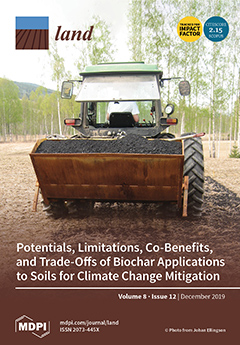Biochar is one of the most affordable negative emission technologies (NET) at hand for future large-scale deployment of carbon dioxide removal (CDR), which is typically found essential to stabilizing global temperature rise at relatively low levels. Biochar has also attracted attention as a
[...] Read more.
Biochar is one of the most affordable negative emission technologies (NET) at hand for future large-scale deployment of carbon dioxide removal (CDR), which is typically found essential to stabilizing global temperature rise at relatively low levels. Biochar has also attracted attention as a soil amendment capable of improving yield and soil quality and of reducing soil greenhouse gas (GHG) emissions. In this work, we review the literature on biochar production potential and its effects on climate, food security, ecosystems, and toxicity. We identify three key factors that are largely affecting the environmental performance of biochar application to agricultural soils: (1) production condition during pyrolysis, (2) soil conditions and background climate, and (3) field management of biochar. Biochar production using only forest or crop residues can achieve up to 10% of the required CDR for 1.5
C pathways and about 25% for 2
C pathways; the consideration of dedicated crops as biochar feedstocks increases the CDR potential up to 15–35% and 35–50%, respectively. A quantitative review of life-cycle assessment (LCA) studies of biochar systems shows that the total climate change assessment of biochar ranges between a net emission of 0.04 tCO
eq and a net reduction of 1.67 tCO
eq per tonnes feedstock. The wide range of values is due to different assumptions in the LCA studies, such as type of feedstock, biochar stability in soils, soil emissions, substitution effects, and methodological issues. Potential trade-offs between climate mitigation and other environmental impact categories include particulate matter, acidification, and eutrophication and mostly depend on the background energy system considered and on whether residues or dedicated feedstocks are used for biochar production. Overall, our review finds that biochar in soils presents relatively low risks in terms of negative environmental impacts and can improve soil quality and that decisions regarding feedstock mix and pyrolysis conditions can be optimized to maximize climate benefits and to reduce trade-offs under different soil conditions. However, more knowledge on the fate of biochar in freshwater systems and as black carbon emissions is required, as they represent potential negative consequences for climate and toxicity. Biochar systems also interact with the climate through many complex mechanisms (i.e., surface albedo, black carbon emissions from soils, etc.) or with water bodies through leaching of nutrients. These effects are complex and the lack of simplified metrics and approaches prevents their routine inclusion in environmental assessment studies. Specific emission factors produced from more sophisticated climate and ecosystem models are instrumental to increasing the resolution and accuracy of environmental sustainability analysis of biochar systems and can ultimately improve the characterization of the heterogeneities of varying local conditions and combinations of type feedstock, conversion process, soil conditions, and application practice.
Full article





